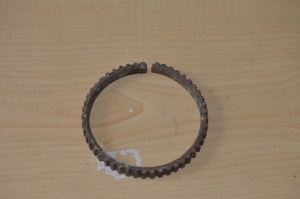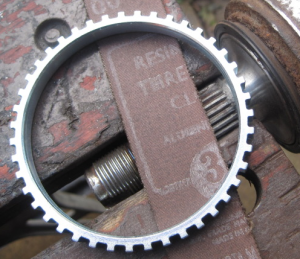I've written before about the “old days” of the 70s and 80s when cars were becoming a bit more sophisticated but still pretty manual in most ways. Take brakes, for example. Back in the day, if you had a brake problem, you simply looked for a leak, worn pads, shoes, drums or rotors or you started taking cylinders apart to see if the seals were gone. These days, a brake problem is always indicated by a light on the dash glowing the dreaded “ABS” or its international symbol. The brake system has gone from a fairly straightforward hydraulic system with masters, slaves and lines to one incorporating pumps, sensors, wires, and rings along with those old bits that we have known for decades.
With the ever increasing automation of the car, we are now inclined to first think that any issue that presents itself is associated with a sensor or one of the other electrical bits present in most automotive systems. In ABS systems, the wheel sensors, located down in the grit, water, and grease of the wheel hub, are usually the simplest culprits to suspect and a fair number of these are replaced almost by default. The ABS sensor, however, isn't the entire part of the sensing function in the system. The sensor, being a Hall effect transducer, changes its electric signal in response to a change in a magnetic field.
The metallic trigger causing this change can be a metal ring with regularly-spaced holes (as used by VW, BMW, and Mercedes) or a toothed ring (as used by Volvo, Ford, SAAB and many others) not dissimilar to the ring gear on the flywheel albeit much smaller. In either case, the processor, in a nominally functioning ABS system, expects to see “X” number of impulses per second from each wheel sensor at any given speed. If the number of impulses changes upon braking, then the processor activates the ABS functionality per its programming. The ABS warning is activated when something prevents the system from seeing what it expects to see in any given situation. Just as you would expect.
This winter, I had the ABS light appear on my '02 Volvo V70. Because of its age, mileage (over 350K kms) and today's natural tendency of sensor suspicion, I immediately expected to see my VIDA/DiCE report a dead wheel sensor. In fact that is exactly what VIDA/DiCE reported, but it also suggested the possibilities of damaged wiring or a damaged reluctor ring. Fortunately, VIDA/DiCE does accurately report which wheel is causing the light so I was able to pull the passenger side front sensor without too much fear of entering a rabbit hole. Close examination of the sensor and its wiring showed no obvious signs of any problems. Its never easy, is it? I then looked down into the sensor hole in the hub carrier. Sure enough, there was a toothed ring in there but it looked rusty and didn't look like it was part of the CV housing like they normally do one when you see one on a new Volvo axle. A bit of messing about with a flashlight and putting my head into the inter workings of the front suspension revealed nothing obvious. Volvo tucks the reluctor ring on the CV housing right next to the seat of the housing to the wheel bearing, all within the hub carrier and therefor tough to get a clear view. But a bit of wheel turning and screwdriver poking finally did reveal the problem. A reluctor ring broken between two teeth, allowing the ring to freely rotate around the CV housing and sending inconsistent magnetic pulses to the ABS processor.

Apparently, this is a fairly common occurrence in those cars using the tooth ring design and which operate in a high rust environment. Rust forming between the ring and the CV housing gradually expands the ring to the point where it fails at the weakest point in a land between two teeth. In the environment here where I live with salt air and road salt, I've been told that a fair number of ABS issues associated with Fords and Volvos are split reluctor rings caused by rust and freezing water.
The purpose of my writing here is not to outline the replacement of the ring, although it is a fairly straightforward procedure. On a Volvo it does not even require the removal of the axle, or any of the suspension bits like the hub carrier. You merely need to be able to get to the outer CV housing and free it from the hub carrier. There are many videos on the Web that show how. My main purpose is to point out that rather than pursuing a path that ends up replacing a wheel sensor for something north of $70 or as suggested by one local mechanic, the replacement of the whole axle (more than $100), the simple replacement of a broken reluctor ring for less than $10 and a bit of labour (took me about 40 minutes to DIY) will sort the problem.
A classic example of Occam's Razor.
About the Author: Uilleam Ross
 Uilleam (Bill) Ross is a 60 year-old retired 30-year veteran of the IT industry and a 45-year car guy. Living in Western Head, Nova Scotia, he now indulges his passions for landscape photography and cars, principally Volvo's and Land Rovers.
Uilleam (Bill) Ross is a 60 year-old retired 30-year veteran of the IT industry and a 45-year car guy. Living in Western Head, Nova Scotia, he now indulges his passions for landscape photography and cars, principally Volvo's and Land Rovers.











